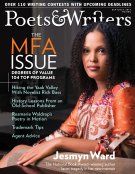So you want to propose a new program that would help people read poetry in an analytical way, or maybe help people teach others to do so?
Exactly. One of the things I’d like to do in Chicago is work with universities that have both teacher-education programs and MFA programs and get them talking to each other, and bring in skilled poet-teachers to work with K–12 teachers to make them more comfortable reading and teaching poetry. And out of that I’d like to create a hybrid program in the Chicago school system. And if it’s successful, I’d like to go national.
The foundation also operates the Harriet Monroe Poetry Institute, a sort of think tank that works in three-year cycles. What I’d like the next cycle to focus on is enhanced e-books of poetry collections from the twentieth century that are modeled after the Criterion Collection DVDs. In a book we’d work on—some of the titles under consideration would be James Merrill’s Divine Comedies, Gwendolyn Brooks’s A Street in Bronzeville, Marianne Moore’s Observations, Frank Bidart’s Desire, John Ashbery’s Self-Portrait in a Convex Mirror—you’d get an authoritative text, including all of the draft material and whatever audio and visual material that exists of the writer reading the work, [along with] selected commentary and letters or interviews by the writer that exist. People are very interested in how movies get made, and I don’t see any reason why they wouldn’t be interested in discovering how a favorite book of poems was created.
That sounds promising.
I think so too. And the hope would be that out of that might also come something like an industry standard for the publication of poetry in e-book form. I’d love to have a symposium in Chicago of all the people publishing poetry e-books and draft some basic guidelines on, for example, how line breaks are coded, so that if you’re reading a poem on your iPhone or iPad, it can survive the transfer from one format to another.
You’re still an active poet, yes?
Yes. My most recent book, Hollywood & God, came out in paperback in June [from the University of Chicago Press].
Did you ever publish poems in Poetry?
No, I never did.
Did you submit poems to the magazine?
I did, decades ago. But you know, a number of poems in my books, including Hollywood & God, didn’t come out in magazines before they were collected, in part because I saw them as sort of working together to create an overall continuous effect.
You’ve written a lot about film noir and noir fiction. What is it that fascinates you about noir?
I think I came to noir through Samuel Beckett, actually.
Was Beckett interested in noir?
Not that I know of, but certainly the darkness that’s in most of American noir will be familiar to readers of Beckett. The line I always fall back on is that noir is all those beautiful sentences telling you the most horrible things. And when you look at the language of Dashiell Hammett or Jim Thompson or Patricia Highsmith, it’s extraordinary. I’m also interested in the way noir is part of the American experimental tradition. What got me interested in Thompson, for example, was his first book, A Hell of a Woman (Lion Books, 1954). It opens with a fairly conventional kind of first-person narration, and after the first crime, the novel explodes and the narrator, in a different, kind of crazed first-person voice, goes back over the same material. That kind of zigzag continues through the whole book through the final pages, where you have an ending that alternates lines of roman and italic type. You have these two equally strange, equally gruesome endings, but it’s almost impossible to read because, you know, do you read it the way it’s printed on the page, or do you read all the sentences in roman, then come back to the italics? It’s an experimental and innovative as anything done in American fiction.
Kevin Nance is a contributing editor of Poets & Writers Magazine.










Comments
Janelle Fila replied on Permalink
It is always interesting when
It is always interesting when new management takes over. I hope it is a smooth transition for all! Janelle www.janellefila.com